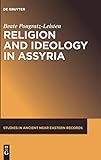Religion and Ideology in Assyria / Beate Pongratz-Leisten.
Material type: TextSeries: Studies in Ancient Near Eastern Records (SANER) ; 6Publisher: Berlin ; Boston : De Gruyter, [2015]Copyright date: ©2015Description: 1 online resource (553 p.)Content type:
TextSeries: Studies in Ancient Near Eastern Records (SANER) ; 6Publisher: Berlin ; Boston : De Gruyter, [2015]Copyright date: ©2015Description: 1 online resource (553 p.)Content type: - 9781614514824
- 9781614519546
- 9781614514268
- 950
- BL1620 .P66 2015
- BL1620
- online - DeGruyter
- Issued also in print.
| Item type | Current library | Call number | URL | Status | Notes | Barcode | |
|---|---|---|---|---|---|---|---|
 eBook
eBook
|
Biblioteca "Angelicum" Pont. Univ. S.Tommaso d'Aquino Nuvola online | online - DeGruyter (Browse shelf(Opens below)) | Online access | Not for loan (Accesso limitato) | Accesso per gli utenti autorizzati / Access for authorized users | (dgr)9781614514268 |
Frontmatter -- Acknowledgments -- Contents -- Abbreviations -- 1. Introduction -- 2. The Dynamics of Cultural Regions and Traditions in Mesopotamia and the Rise of Assyrian Cultural Discourse -- 3. The Origins of Assyrian Cultural Tradition -- 4. Empire as Cosmos, Cosmos as Empire -- 5. Narratives of Power and the Assyrian Notion of Kingship -- 6. Administrator, Hunter, Warrior: The Mythical Foundations of the King’s Role as Ninurta -- 7. The King’s Share in Divine Knowledge -- 8. Between the Fictive and the Imaginary -- 9. The Individual Ruler as a Model for Kingship: Rethinking Ancient Historiography -- 10. The Reinvention of Tradition: The Assyrian State Rituals -- 11. The Voice of the Scholar -- Appendix -- Bibliography
restricted access online access with authorization star
http://purl.org/coar/access_right/c_16ec
Addressing the relationship between religion and ideology, and drawing on a range of literary, ritual, and visual sources, this book reconstructs the cultural discourse of Assyria from the third through the first millennium BCE. Ideology is delineated here as a subdiscourse of religion rather than as an independent category, anchoring it firmly within the religious world view. Tracing Assur's cultural interaction with the south on the one hand, and with the Syro-Anatolian horizon on the other, this volume articulates a "northern" cultural discourse that, even while interacting with southern Mesopotamian tradition, managed to maintain its own identity. It also follows the development of tropes and iconic images from the first city state of Uruk and their mouvance between myth, image, and royal inscription, historiography and myth, and myth and ritual, suggesting that, with the help of scholars, key royal figures were responsible for introducing new directions for the ideological discourse and for promoting new forms of historiography.
Issued also in print.
Mode of access: Internet via World Wide Web.
In English.
Description based on online resource; title from PDF title page (publisher's Web site, viewed 28. Feb 2023)


